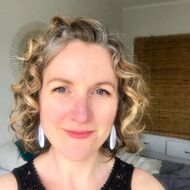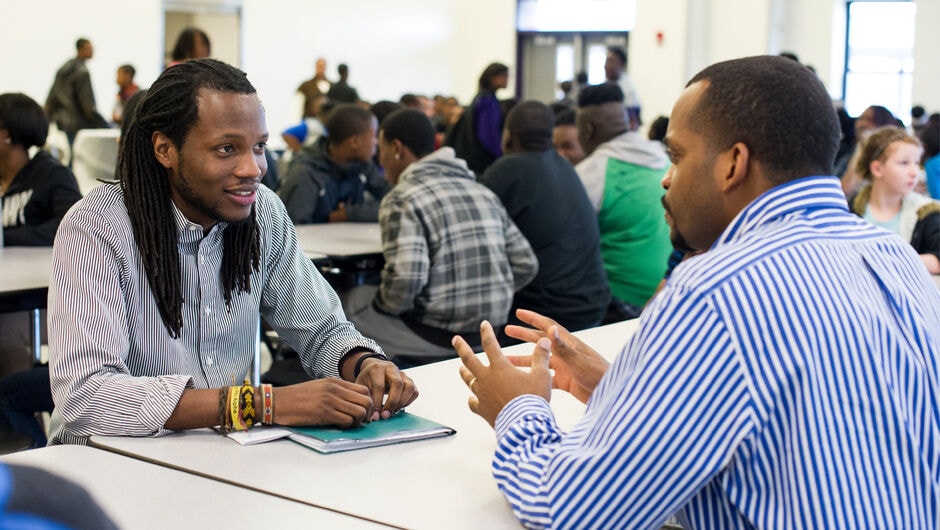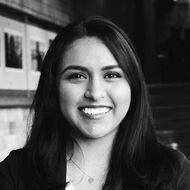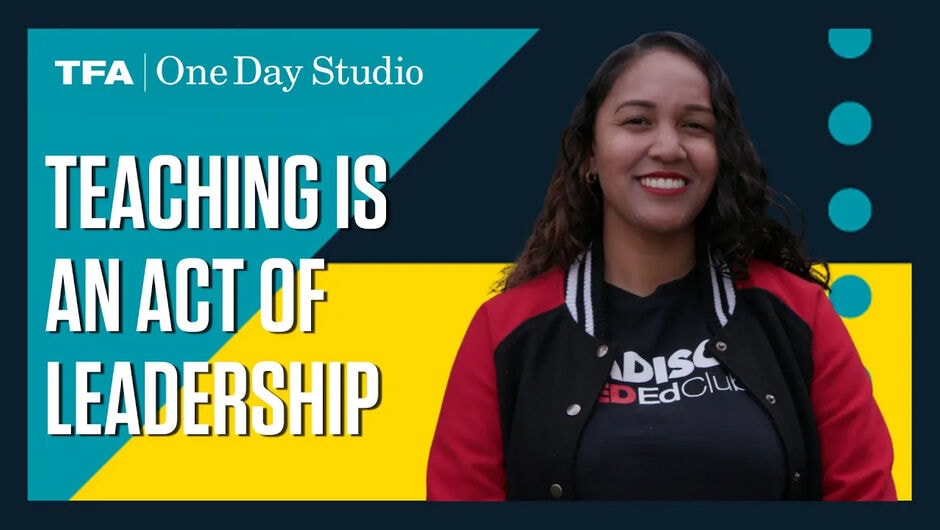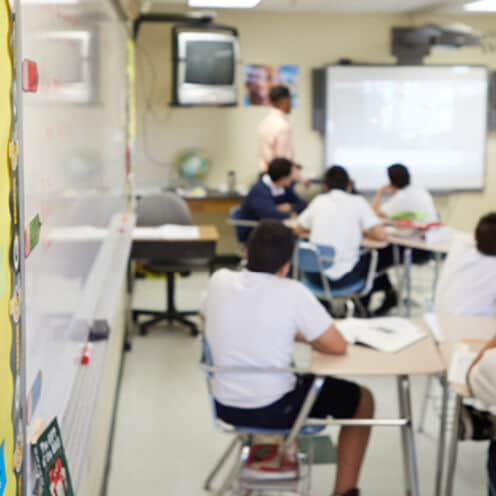
I See Me: Representation of LGBTQ+ Teachers in the Classroom
For Pride Month LGBTQ+ educators share why an equitable education must include increasing visibility and support for LGBTQ+ students and teachers.
During Kristal Torres’s sophomore year of high school, she transferred from an all-girls Catholic school to a coed public high school. After keeping her queer identity under the radar for so long, the move to the new school signaled a big transition.
Kristal discovered the school’s Gender and Sexuality Acceptance (GSA) club where she met Dr. Sanford, a teacher who was openly gay. And for the first time in her life, she had a positive picture of what her future could look like.
“I remember thinking, Wow, look at her. She's an adult and she's out and people don't care. She is confident in her sexual orientation and who she is. And she was unapologetically herself,” Kristal says. “I remember thinking, I want to be like that.”
Kristal has taught pre-K and kindergarten for six years, after joining the 2014 corps in New York City. She is committed to making her classroom an open and affirming place for her young students as they begin exploring their own identities--something she didn’t have growing up.
Unfortunately, far too many students who identify as LGBTQ+ report that they do not feel safe at school because of their sexual orientation or gender expression. These students are at higher risk for missing days of school, dropping out, and experiencing serious mental health issues. Yet studies have also found that the presence of supportive and affirming teachers, including those who share students’ LGBTQ+ identities, means LGBTQ+ students are more likely to attend school, have higher self-esteem, and achieve better academic outcomes.
Educators across Teach For America’s network are working to ensure that more students across the country are able to have that vital connection to a teacher who shares their identities by launching more than 25 Prism boards—a network of support groups for LGBTQ+ and allied educators—in regions across the country. This LGBTQ+ Pride Month educators from across TFA’s Prism network share how their experiences with LGBTQ+ teachers and mentors shaped who they are today and continue to fuel their fire for increasing visibility and creating more safe and inclusive schools.
Seeing Myself, Imagining My Future
Without LGBTQ+ Teachers, It Was Hard to Understand My Place in The World
“I grew up in an upper middle class, religious area in Ohio where it didn't really feel like gay people existed. I had friends in theater who were gay, but I didn't see any examples of what life would be like as a gay adult. It wasn't until I was in college and had professors who were gay that I really had any picture of what it was like to be a gay adult in a regular relationship with a family.”
Lainie Augensen (Greater Chicago-Northwest Indiana ‘15) Assistant Principal
“I feel like I could have had a lot of questions answered, especially about what my life could look like. I'm a very future-oriented person. But it was always kind of hazy. I’d sometimes try to fit it into this heteronormative box of what it would look like, but it felt wrong.”
Gargi Sundaram (Indianapolis ‘18) High School Biology Teacher
“If I had teachers who shared my identity, I think I would have been less scared when I was navigating my identity as a teenager. I was actually outed by a girl in my grade. Getting outed was a scary experience that I had to deal with alone since I had no one at all who understood what that felt like.”
Brian Tussey (Kansas City ‘18) ESL Teacher
My LGBTQ+ Teachers Helped Me Navigate My Identity
"I didn't have a teacher who I knew identified until my sophomore year of college. And then I had one more teacher who identified as a lesbian my senior year of college. Neither of them ever talked about it as if it were a burden or something they wanted to get rid of. Instead, it was like something that they were proud to identify as, and that really helped me during my coming out period during my junior year of college."
Lexia Banks (Alabama ‘18) Middle School Social Studies Teacher
“One of the first teachers I had who identified as LGBTQ was in high school. They incorporated a lot of literature that was both dynamic and explored sexual identity and brought out the humanity of the characters that they chose to analyze within that class. I think for me it was really, really helpful to feel like I was appreciated. Like I was seen, heard, and visible.”
Adam Mogilevsky (Eastern North Carolina ‘15) Middle School Lead Humanities Teacher
My Role as a Queer Educator
I Want My Students To Feel Safe, Seen, and Supported
“For my students who have grown up in cultures in which coming out as LGBTQ+ could result in violence, having a safe person to talk with about their sexual orientation without fear of retribution is important to them and improves their self-image and sense of belonging.”
Brian Tussey (Kansas City ‘18) ESL Teacher
“This year I've been very openly out with students, but a lot of that was motivated by my first year of teaching where I was trying to combat issues of homophobia and transphobia. No matter what, there are definitely LGBTQ kids walking around in this building, feeling hostility not only from their peers but from the adults who are supposed to care for them. And it made me realize I have to be what I never got as a student.”
Abigail Bouwma (Indianapolis ‘17) High School Special Education Teacher
“I think our LGBTQ students have really benefited from seeing us as completely normal (and often boring) adults who happen to share their same identity. It has normalized LGBTQ relationships for many of our students in a really helpful way.”
Lainie Augensen (Greater Chicago-Northwest Indiana ‘15) Assistant Principal
Creating Safe Spaces Inside and Outside the Classroom For Students to Explore Their Identities
“Since we've not been in school, we have a Google Classroom GSA. So we're still able to be in contact with each other even though we're not necessarily together. Just being able to build that space and send resources for students who are in households where it's okay, but also keeping in mind those students who are feeling isolated in a household where their identities aren't accepted.”
Sam Slavinsky (South Dakota ‘13) Learning Behavior Specialist/Athletic Director/GSA Advisor
“Even though kids might not know what a gender norm is, they are taught early on that girls clean and boys do the heavy lifting. One of my favorite parts about teaching is that even though I don't exclusively identify as male, I'm showing the boys in my class that there are different ways to be a boy, and the girls, that there are different ways to be feminine.”
Cody Burke (South Carolina ‘19) Elementary English Teacher
“My first year had a little boy named Justin. His mom called him “flamboyant.” I did a home visit where I spoke to the mom and I remember telling her that I was actually gay and I think it really helped her and made her feel more relieved. I think she was grateful to be able to talk to me as somebody who did identify with the LGBT community. I reassured her that everything was going to be okay.”
Kristal Torres (New York ‘14) Pre-K Teacher
I Make Sure Our Stories Are Told, Even If They Are Left Out of the Curriculum
“There was no LGBTQ content in my school's curriculum or really for the entire state, so I had to make it for myself. It was always part of my classroom. Even if it wasn't going to show up in the standards or the textbook, my students walked away with some kind of information relevant to the community.”
Lexia Banks (Alabama ‘18) Middle School Social Studies Teacher
"One of my students has two moms at home so it was super important that I was including that in the visibility of my classroom. I started bringing those examples into reading comprehension exercises and word problems in math so that we can start normalizing the reality that love and family are complex for a lot of reasons."
Laur Plawker (Baltimore ‘18) Elementary Special Education Teacher
“At my school, we have monthly themes, such as Indigenous heritage month, Hispanic heritage month, Black history month, and we read about people who fit those identities. But there are also queer people who fit all of those identities. So I made it a very clear effort to include those stories as well.”
Cody Burke (South Carolina ‘19) Elementary English Teacher
LGBTQ+ Mentors Make a Difference
If I Had an LGBTQ+ Mentor, I Would Have Understood Who I Was Much Sooner
“When I was working in corporate, I was out and unapologetically gay. But when I transitioned to become a teacher, I felt like it was something that was going to be perceived as taboo, especially because I was working with little kids. So I think that if I had somebody who was a mentor, I would have been able to talk to them about that. And I think they would have given me insight on how to navigate that at the beginning of my teaching career.”
Kristal Torres (New York ‘14) Pre-K Teacher
“I had a lot of really strong women allies and people of color as allies as I was growing up. I think that they allowed me space to discover who I was and like take stock of my life. I think if I had that more LGBTQ+ people of color in my professional life, I would have been able to recognize certain things that took me a long time to recognize on my own.”
Gargi Sundaram (Indianapolis ‘18) High School Biology Teacher
I Want To Be The Person I Needed When I Was Younger
“I was the first person to come out at my high school while I was there. And then I started getting messages from other people in younger grades who were asking, how do I come out? How do I tell my friends? How do I tell my parents? And it was cool that even at 16, I got to help other people go through that.”
Cody Burke (South Carolina ‘19) Elementary English Teacher
“In terms of students, it’s so impactful to a lot of them to have somebody that they know is going to be accepting and loving of them in their identities no matter what. It brings me a lot of joy and a lot of life. It's not always the easiest thing, because oftentimes these students come with a lot of trauma and a lot to unpack. But I just really enjoy being a stable figure in their lives and someone that can help.”
Zoey Kapusinski (Oklahoma City ‘17) High School Biology Teacher, GSA Advisor
“Most of the kids coming to me really just needed to hear that the way that they felt or thought, was legitimate and that they were normal and that it didn't change who they were as a person. Especially for students who did identify because middle school is already extremely tough on those who are different.”
Lexia Banks (Alabama ‘18) Middle School Social Studies Teacher
Interested in Joining Teach For America?
Teach For America CEO Statement on Supreme Court Ruling Upholding Employment Protections for LGBTQ+ Individuals. "It’s a day to celebrate on the road to real equality. We are in solidarity and community with our LGBTQ+ family.” Read TFA’s statement on the Supreme Court ruling in favor of workplace protections for LGBTQ+ employees.
We’re Still Fighting For Our Right to Exist
Not Every School Is A Safe Place For LGBTQ+ Teachers
“I think having LGBTQ+ representation in education is difficult due to the hostility we face from numerous fronts. Ideally, more representation would make school more hospitable for students, teachers, and other school employees. Students deserve to have teachers who are knowledgeable about LGBTQ+ issues and who can help them understand their own identities. It is up to those in power to allow that to happen.”
Brian Tussey (Kansas City ‘18) ESL Teacher
“I think representation really does matter. The only downside is that there are very little protections and support systems for LGBTQ educators. I think if we had far more representation of educators who are LGBTQ, we would be able to eliminate some of these barriers that keep them from being their full, vulnerable selves.”
Adam Mogilevsky (Eastern North Carolina ‘15) Middle School Lead Humanities Teacher
Why Representation Matters
Visibility Comes With Validity
“I think visibility also comes with validity. Just the fact that I'm able to exist as a hundred percent of who I am in this space comes with validity for any student who shares my queer identity.”
Sam Slavinsky (South Dakota ‘13) Learning Behavior Specialist/Athletic Director/GSA Advisor
“I think that a greater representation of LGBTQ educators and leaders would remove a lot of shame that kids can feel. It would also help students have more traditional experiences of growing up—going to a school dance with someone you have a crush on, sending a valentine, holding hands after school.”
Lainie Augensen (Greater Chicago-Northwest Indiana ‘15) Assistant Principal
When Students’ Identities Are Affirmed, More Learning Can Take Place
“Teaching kids about their identity is the greatest way to get them invested in learning because everyone wants to know more about who they are. I think that it is important that everything in a school—from the curriculum to the staff to the highest administration—represents the world that kids are walking into.”
Abigail Bouwma (Indianapolis ‘17) High School Special Education Teacher
"I think if we had more LGBTQ+ educators and system leaders, there would be less bullying and harassment in schools. There would be a lot more love and inclusivity. "
Zoey Kapusinski (Oklahoma City ‘17) High School Biology Teacher, GSA Advisor
“Being able to provide space where students can bring their whole person into the classroom and not have to check any part of their identity at the door—what a freeing experience that would be. They can just use one hundred percent of their brain on the task at hand instead of being worried about how to navigate in different spaces.”
Sam Slavinsky (South Dakota ‘13) Learning Behavior Specialist/Athletic Director/GSA Advisor
The Future Depends on Understanding Diverse Perspectives and Identities
“I think any time you're representing someone that doesn't look like what you see every day in your personal life or in society around you, it's an opportunity for you to learn about other people and to really be able to build relationships across lines of difference.”
Gargi Sundaram (Indianapolis ‘18) High School Biology Teacher
“Love is the guiding force behind education. But when our capacity to love is viewed as somehow different from the teacher next door's capacity to love or the way that they love, that is not only damaging to us as LGBTQ+ educators, it's damaging to children and the ways that they get to experience the world.”
Laur Plawker (Baltimore ‘18) Elementary Special Education Teacher
“I think it would have a significant impact on our students, not just those who identify, but straight students as well because you're building relationships, you're getting to know each other. That's how you develop empathy and compassion for people who are different from you. That's how you help build more allies, and I think the younger that you start to expose kids to people who are different from them, the better.”
Lexia Banks (Alabama ‘18) Middle School Social Studies Teacher
Sign up to receive articles like this in your inbox!
Thanks for signing up!
Content is loading...


